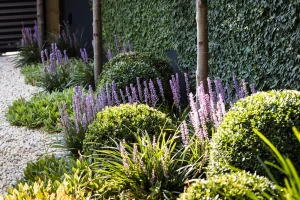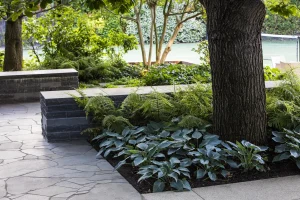An edible garden is a garden that includes vegetables, fruits, herbs, seeds and flowers – essentially anything that you can eat! If you’ve always dreamed of creating an edible garden in your home, there are a few key things to consider before you start planting. To help you get started, we’ve created the ultimate guide to creating an edible garden.

Designing your edible garden
Before you start planting herbs and vegetables, it’s essential to consider the design of your garden and how it will logistically work in your landscape. Some key questions you should be asking yourself are:
1. How big will my garden be?
One of the best things about an edible garden is that it can be ANY size. Edible gardens are equally effective on apartment balconies as they are on properties with acreage. You can plant in pots, raised garden beds or straight into the ground – it’s up to you.
2. What is the best place for the garden?
Generally speaking, the best place for an edible garden will be a spot that gets a decent amount of sun and has easy access to water. This will vary depending on the type of plants you want to grow. For example, if you’re going to grow a passionfruit vine – it would be best to plant in front of a north-facing wall that gets plenty of sunlight and will promote climbing. Spinach, on the other hand, loves shade.
3. What is the state of your soil?
Trust us when we say good soil is king. The best soil for creating edible gardens is well-drained soil rich in organic matter and soil life. Worms and composting are your friend here! You can learn more about the benefits of composting here.
4. Will I need any additional infrastructure?
Some gardeners may install sheds, greenhouses, cupboards or potting benches to assist in their gardening endeavours. If you are going to build infrastructure, consider whether it will remove any light from your garden and the position of the infrastructure (i.e., is it easy to access and close to the garden?)
5. What will I plant my edible garden in?
Depending on your space, you may choose to plant crops and seeds directly into the ground or use a container. Suitable options for containers include:
- Raised garden beds – these can be purchased or custom-built
- Large plastic or stone pots – make sure there are holes for drainage!
- Old wheelbarrows
Selecting plants for your edible garden
Now, for the fun stuff – picking the plants for your edible garden! Before you start planting, ask yourself what you eat regularly and what would you benefit from in the garden? Do you want fresh produce to cook with every day or just some herbs to finish off that creamy pasta? Planting foods that you enjoy will ensure you make the most out of your garden.
When selecting plants for your edible garden, you need to consider the climate of where you live and the seasonality. For example, bananas are typically grown in tropical climates and likely wouldn’t thrive in the inner-city suburbs of Melbourne. Fruits, vegetables, herbs and seeds also grow best at different times of the year. For example, Silverbeet grows excellent in winter, whereas basil loves summer. When purchasing your seeds or seedlings, check the packet/ tag for its seasonality or chat to the staff at your local nursery.
Some plants that you may like to include in your garden are:
Flowers (great for tea)
- Carnation
- Chamomile
- Hibiscus
- Lavender
- Salvia
- Rose
- Chrysanthemum
Herbs/ Seeds
- Basil
- Rosemary
- Mint
- Chives
- Sage
- Oregano
- Parsley
- Thyme
- Chilli
- Bay leaf
- Sunflower seeds
- Pumpkin seeds
Vegetables
- Lettuce
- Tomatoes
- Spring onion
- Spinach
- Silverbeet
- Capsicum
- Carrots
- Cauliflower
- Leek
- Corn
Fruit and Citrus
- Strawberries
- Blueberries
- Lemons
- Limes
- Apricots
- Figs
- Passionfruit
- Kiwi Fruit
- Rhubarb
The Hungry Gardener has created a fantastic resource that outlines the best time of year to plant seeds, based on your climate. You can download this here.
Ensuring your edible garden thrives
Now that you’ve designed your edible garden, selected your plants, and planted them in the soil – how do you ensure it stays alive? We’ve outlined some of our essential tips below:
- Compost! You can read more about the benefits of this here
- Remove weeds regularly as they will compete with your plants to receive valuable nutrients
- Use organic fertilisers (chat to your local nursery about the best fertiliser to use in your garden)
- Use non-chemical remedies to keep pests away (this is especially important as you will be eating the plants in your garden)
- Mulch – this will help to keep the moisture in
If a plant dies, don’t be disheartened – creating an edible garden can be challenging and rewarding. Especially in the early stages, there will likely be a lot of trial and error, which will help you identify which plants will thrive best in your garden.








